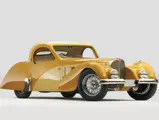Villa d'Este 2011
1937 Bugatti Type 57SC Atalante Coupé
{{lr.item.text}}
€3,250,000 - €4,250,000 EUR | Not Sold
 | Cernobbio, Italy
| Cernobbio, Italy
{{internetCurrentBid}}
{{internetTimeLeft}}

200 hp, 3,257 cc supercharged DOHC inline eight-cylinder dry-sump engine, four-speed manual gearbox, hollow front axle with semi-elliptic leaf springs, live rear axle with reversed quarter-elliptic leaf springs and torque arm, and four-wheel cable-operated mechanical drum brakes. Wheelbase: 2,980 mm (117.3")
- One of just over 40 Type 57S chassis built and one of only 17 Atalante Coupés
- Fascinating history; long-term ownership and restoration within Harrah Collection
- Best of Show, 26th Pebble Beach Concours d’Elegance (1976)
- Fastidiously maintained within noted collection
- Documented by marque expert David Sewell
The Type 57 Bugatti was an entirely new design under the direction of Le Patron’s talented son, Jean Bugatti. Production began in 1934 and continued until 1940. The Galibier sedan, Ventoux coach (two-door sedan) and Stelvio drophead coupé comprised the bulk of production, followed by the later Atalante Coupé, with coachwork built in Bugatti’s Molsheim coachworks or by Gangloff in nearby Colmar. Demand for sporting versions prompted the Grand Raid Roadster in 1934, the Type 57T with torpedo coachwork in 1935 and, the ultimate variant, the Type 57S and SC.
The Sporting Type 57S
The surbaissé (lowered) Type 57S “Sport” chassis featured deep-section frame rails through which the rear axle passed, enabling further streamlining. Other advancements included a dry-sump oiling system derived from the T59 GP car. A Roots-type supercharger was also available, raising power output and top speed to 200 hp and some 120 mph, respectively. The T57S was introduced in late 1937 and just over 40 production examples were built in total, of which just 17 were fitted with elegant Atalante Coupé coachwork. Of total 57S production, only two cars were fitted from the factory with superchargers, rendering them “57SC” examples. The vast majority of supercharged Type 57S’s, however, were upgraded to “SC” specification later in life.
Chassis no. 57551
This Bugatti, chassis 57551, has a remarkably complete and fascinating history. According to the definitive Bugatti: Les 57 Sport by Pierre-Yves Laugier, 57551 was the first of four Type 57 Atalante Coupés (57551, 57552, 57562 and 57573) produced with streamlined headlamps during the summer of 1937.
Road tested on 4 June, 1937, 57551 was completed and left Bugatti’s Molsheim coachworks with Atalante coachwork on 23 July, 1937. Just three days later, it was delivered to first owner Mr. Jean Lévy, the Deputy Administrator of the family-owned “Grands Moulins de Strasbourg,” a grain-milling company established by his father that still operates today.
Mr. Lévy used the Atalante until the outbreak of World War II and then hid it on a family-owned farm in Dordogne. The Lévy family transferred ownership of 57551 to Maurice Weber, a livestock feed manager at the Grands Moulins and a trusted friend, on 7 June, 1941. Mr. Weber hid the car for the war’s duration, and on 8 March, 1946, it was sold in Paris, with the transaction believed to have been authorised by Jean Lévy himself. In July 1947, 57551 was sold to Mr. Pierre Pruvost of Bezons, France.
Mr. Pruvost retained 57551 for less than a year, and on 5 May, 1948, it was acquired by a Parisian owner and then displayed at the International Concours d’Elegance de Confort et de Technique de la Carrosserie, held 15 June, 1949, by which point its coachwork had been professionally restyled and modified, perhaps even by Figoni. On 9 December, 1949 it changed hands once more, before well-known French artist André Derain, a contemporary of Matisse and Vlaminck and a later colleague of Picasso, acquired the car in May 1951. Mr. Derain retained the car until May 1952 before 57551 found its way to Nice in November the following year, in the ownership of Mrs. Monique Weyener. While still in France, the gearbox was replaced, as was the crankcase, which has since been re-stamped with “30S,” the correct number for this particular car, chassis 57551.
The car then passed through four additional known owners before it was shipped to the United States in 1959 for Colin Downe. In the spring of 1961, Mr. Downe sold the Atalante to casino magnate and noted classic-car collector William Harrah of Reno, Nevada. O.A. “Bunny” Phillips was assigned the task of restoring the car’s chassis and mechanical components. Chassis 57551 was completely disassembled, and the body was removed from the chassis and stored in an airplane hangar in Reno. The frame and its components were found to have remained in excellent condition.
Mr. Phillips completed the chassis and the mechanicals and installed a factory original supercharger, elevating the car to the ultimate “SC” specification. The engine block was damaged and therefore replaced by a correct unit.
The body was returned to its original form and was beautifully refinished in the two-tone scheme of Patrol Cream and Lemon Oxide. The only deviation from the original form is the shape of the rear wings, which more closely resemble that of the Gangloff-bodied 57S and, again, was modified in period when the car was only about ten years old.
Completed on 27 August, 1976, the Bugatti was awarded Best of Show at the 26th Annual Pebble Beach Concours d’Elegance. In fact, 57551 was the last of Mr. Harrah’s four Pebble Beach Best of Show-winning cars. It was displayed at Harrah’s until eventually being acquired by Dr. Herbert W. Boyer of Mill Valley, California in January 1987. During his custodianship, Dr. Boyer kept 57551 at a small private garage in San Francisco, where it was carefully displayed and road-ready. Noted specialist Phil Reilly performed a complete engine rebuild during the mid-1990s, and ever since then, the Bugatti has been carefully and regularly exercised, albeit only for limited distances.
In 2002, the present owner commissioned a professional cosmetic refurbishment of the Atalante, returning the car to its fully restored glory. Today, it looks every bit as good as it did in the 1970s, a true testament to the meticulous care lavished on it since its Pebble Beach award-winning restoration was completed. With its fascinating and well-documented history from new, supercharged engine and wonderful presentation, this Type 57SC is certainly one of the most attractive, rare and best performing of all Bugatti road cars. It truly epitomises artistry in motion.
200 cv, motore 8 cilindri in linea di 3.257 cc con doppio albero a camme in testa con compressore e carter secco, cambio manuale a quattro marce, assale anteriore rigido cavo con balestre semi-ellittiche, assale posteriore rigido con balestre a un quarto di ellisse rovesciato e braccio di torsione, freni a tamburo con comando meccanico con tiranti. Passo: 2.980 mm (117.3")
- Uno di circa 40 esemplari di Tipo 57S e una delle sole 17 Atalante coupé
- Storia affascinante, per lungo tempo di proprietà dello stesso collezionista, restaurata all'interno della Collezione Harrah
- Best of Show al 26° Concorso d'Eleganza di Pebble Beach del 1976
- Meticolosamente mantenuta in una nota collezione
- Documentata dal esperto Bugatti David Sewell
La Bugatti Tipo 57 nacque da un progetto completamente nuovo diretto dal talentuoso figlio del Patron, Jean Bugatti. Iniziata nel 1934, la produzione continuò fino al 1940 concentrata soprattutto sulla berlina Galibier, il coupé due porte Ventoux e la cabriolet Stelvio, ai quali in seguito si aggiunse il coupé Atalante, la cui carrozzeria fu costruita sia all'interno della fabbrica Bugatti a Molsheim sia da Gangloff nella vicina Colmar. La richiesta di versioni sportive portò alla produzione del Roadster Grand Raid nel 1934, della Tipo 57T con carrozzeria torpedo nel 1935 e quindi alle ultime versioni, la Tipo 57S e SC.
La sportiva Tipo 57S
La Tipo 57S ‘Sport’ (surbaissé) aveva un telaio abbassato, con il ponte posteriore che passava attraverso i longheroni e permetteva quindi linee più aerodinamiche; fra gli altri miglioramenti l'adozione del sistema di lubrificazione a carter secco, derivato da quello della Tipo 59 da Gran Premio. A richiesta era disponibile un compressore tipo Roots che portava la potenza a 200 cv per una velocità massima di oltre 190 km/h. La Tipo 57S fu presentata alla fine del 1937 e ne furono prodotti poco più di 40 esemplari, 17 dei quali con l'elegante carrozzeria coupé Atalante. Delle 57S di produzione, solo due o tre furono dotate di compressore in fabbrica, e denominate 57SC, mentre la maggior parte delle Tipo 57 furono trasformate SC nel corso della loro vita.
Il telaio 57551
La Bugatti telaio 57551 ha una storia affascinante e conosciuta dall'inizio. Secondo il libro Bugatti: Les 57 Sport di Pierre-Yves Laugier, la 57551 fu la prima di quattro Tipo 57 Atalante Coupé (57551, 57552, 57562 and 57573) prodotte nell'estate 1937 con fanali aerodinamici integrati.
Provata su strada il 4 giugno 1937, la Atalante telaio 57551 fu completata e lasciò la fabbrica Bugatti, a Molsheim, il 23 luglio; tre giorni dopo fu consegnata al primo proprietario, il signor Jean Lévy, amministratore delegato dell'azienda di famiglia “Grands Moulins de Strasbourg”, un mulino fondato dal padre e attivo ancora oggi.
Il signor Lévy usò l'Atalante fino allo scoppiò della Seconda Guerra Mondiale, quando la nascose in una fattoria di famiglia in Dordogna. Il 7 giugno 1941, la famiglia Lévy vendette la 57551 a Maurice Weber, un responsabile del reparto mangimi della Grands Moulins e amico fidato, che a sua volta la nascose durante la guerra e la rivendette l'8 marzo 1946, in Parigi, sembra con l'autorizzazione dello stesso Jean Lévy. Nel luglio 1947, la 57551 fu acquistata dal signor Pierre Pruvost di Bezons, in Francia.
Questi la tenne per meno di un anno e il 5 maggio 1948 la rivendette a un parigino che la esibì al Concorso d'Eleganza Internazionale del Comfort e della Tecnica della Carrozzeria, che si svolse il 15 giugno 1949 al Bois de Boulogne, e fu a questo punto che la vettura fu soggetta di un leggero restyling ed accorgimenti di carrozzeria, probabilmente da Figoni. Il 9 dicembre 1949 la vettura passò di mano ancora una volta prima di essere acquistata nel maggio 1951 dal noto artista francese André Derain, contemporaneo di Matisse e Vlaminck e in seguito amico di Picasso. Derain la tenne fino al maggio 1952 e nel novembre dell'anno seguente la 57551 fu acquistata da una certa signora Monique Weyener e portata a Marsiglia. Quando la vettura era in Francia fu sostituito il cambio e anche il supporto albero motore, il quale fu rinumerato “30S,” il numero originale per questa vettura.
La vettura ebbe altri quattro proprietari conosciuti prima di essere spedita via mare nel 1959 negli Stati Uniti a Colin Downe. Nella primavera del 1961, Downe vendette l'Atalante al magnate dei casino e noto collezionista di vetture classiche, William Harrah di Reno, nel Nevada. O.A. “Bunny” Phillips fu incaricato di restaurare il telaio e la meccanica della vettura, che venne completamente smontata e la carrozzeria riposta in un hangar per aerei a Reno. Il telaio e i suoi componenti furono trovati in eccellenti condizioni.
Phillips completò il lavoro su telaio e meccanica e installò un compressore originale, della fabbrica, trasformando così la vettura in “SC”. Il blocco motore era però danneggiata e fu quindi sostituito con una unità corretta.
La carrozzeria fu riportata alla sua forma originale e riverniciata in due colori, crema Patrol e limone Oxide. L'unica deviazione dal design originale della carrozzeria è la forma dei parafanghi posteriori, che ricordando la 57S carrozzata da Gangloff, i quali furono modificati quando al vettura aveva appena 10 anni di vita.
Completata il 27 agosto 1976 (due giorni prima del Concorso), la Bugatti fu eletta Best of Show a Pebble Beach; fu per Harrah l'ultima dei quattro Best of Show vinti a Pebble Beach dalle sue vetture. Esposta quindi nella collezione Harrah, la vettura vi rimase fino al gennaio 1987 quando fu acquistata dal dottor Herbert W. Boyer di Mill Valley, in California. Durante la sua custodia, il dottor Boyer tenne la 57551 in un piccolo garage privato di San Francisco, dove fu esposta con la massima cura e mantenuta per l'uso. Il noto specialista Phil Reilly ha rifatto il motore a metà degli anni Novanta, e da allora la vettura è sempre stata ben tenuta e regolarmente utilizzata, anche se solo su brevi distanze.
Nel 2002, l'attuale proprietario ha commissionato una professionale revisione cosmetica dell'Atalante, riportandola allo splendore del periodo post-restauro. Oggi, ogni dettaglio appare così come era negli anni Settanta, un riconoscimento assoluto della cura meticolosa con cui è stata tenuta fin dai tempi della vittoria a Pebble Beach. Grazie alla sua affascinante e ben documentata storia da nuova, al motore con compressore e alle bellissime condizioni, questa Tipo 57SC è certamente una delle più attraenti, rare e performanti vetture Bugatti stradali. Rappresenta davvero l'arte in movimento.





